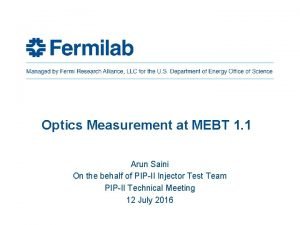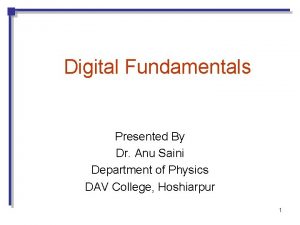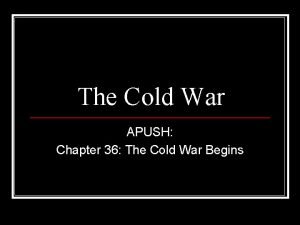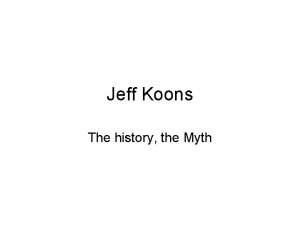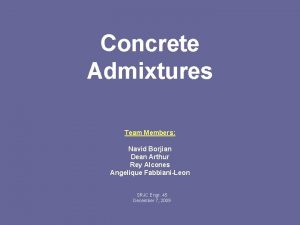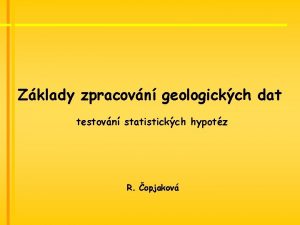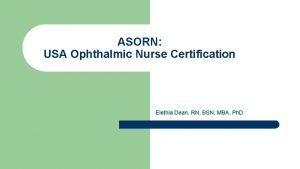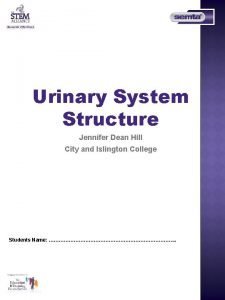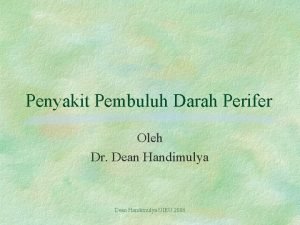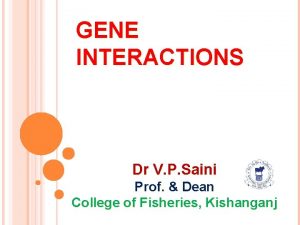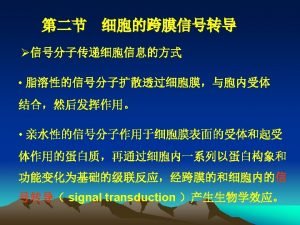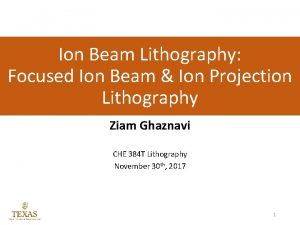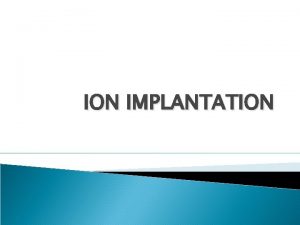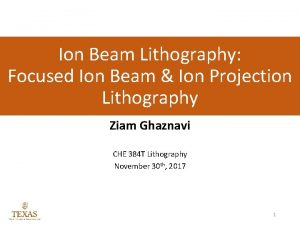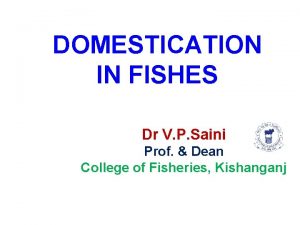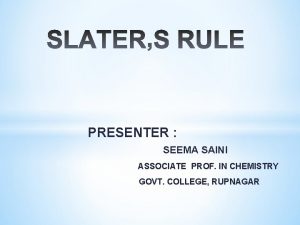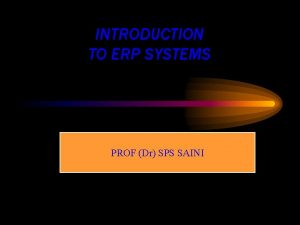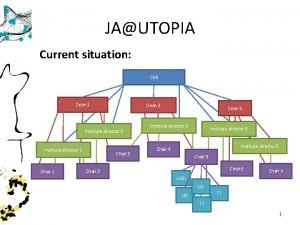CRYOPRESERVAT ION Dr V P Saini Prof Dean







































- Slides: 39

CRYOPRESERVAT ION Dr V. P. Saini Prof. & Dean College of Fisheries, Kishanganj

Cryopreservation is a process where cells or whole tissues are preserved by cooling to low sub-zero temperatures, such as 77 K or − 196°C. Any biological activity, including the biochemical reactions that would lead to cell death, is effectively stopped.

First successful cryopreservation of fish sperm was reported in 1950 s. In fish farming and seed production sector, storage of milt can facilitate, 1)selective breeding 2)hybridisation 3)commercial seed production.

Success of cryopreservation of sperm depends on the seasonality, varying sperm quality, collection diluents techniques, used, precise freezing and thawing regimes, storage conditions, post–thaw fertilization techniques.

RISKS ASSOCIATED WITH CRYOPRESERVATION Damage to cells during cryopreservation occur during the freezing stage, and include, 1)solution effects, 2) extracellular ice formation, 3)dehydration 4)intracellular ice formation. These effects can be reduced by cryoprotectants. Once frozen stage is reached, it is safe from further damage. It has a maximum storage period of 1000 years.

SOLUTION EFFECTS As ice crystals grow in freezing, water solutes are excluded, causing them to become concentrated in the remaining liquid water. High concentrations of some solutes can be very damaging

EXTRACELLULAR ICE FORMATION When tissues are cooled slowly, water migrates out of cells and ice forms in the extracellular space. Too much extracellular ice can cause mechanical damage to the cell membrane due to crushing.

DEHYDRATION The migration of water causing extracellular ice formation can also cause cellular dehydration. The associated stresses on the cell can cause damage directly.

INTRACELLULAR ICE FORMATION Some organisms and tissues can tolerate some extracellular ice, but any appreciable intracellular ice is almost always fatal to cells.

PREVENTION OF RISKS Lethal intracellular freezing can be avoided if cooling is slow enough to permit sufficient water to leave the cell during progressive freezing of the extracellular fluid. The rate differs between cells of differing size and water permeability. A typical cooling rate around 1°C/min is appropriate for many fish cells after treatment with glycerol or dimethyl sulphoxide (DMSO)

METHOD OF CRYOPRESERVATION 1) Sperm collection Stripping Surgical removal of testis 2) Quality evaluation of milt 3) Extenders 4) Addition of cryoprotectant 5) Non cryogenic preservation (short-term) 6) Cryogenic preservation (long term)

STRIPPING Anaesthetize the brood fish with MS 222. Blot fish dry with towel. Gently massage abdomen to expel sperm. Collect sperm in micro-hematocrit tubes, syringes, or centrifuge tubes. Measure volume of sperm and dilute with extender solution (1: 3, 1: 5, 1: 10. ) depending on species.

SURGICAL REMOVAL OF TESTIS Done for fishes from which sperm cannot be stripped. (catfishes, murrels) 1. Anaesthetize fish with MS 222. 2. Blot fish dry with towel. 3. Surgically remove testis from fish.

4. Remove excess blood and tissue from testis using cotton or tissue paper. 5. Weigh testis. 6. Measure extender solution (10 to 20 ml per g of testis). 7. Crush testis to release sperm in a dry clean dish.

QUALITY EVALUATION OF MILT • • Quality changes depending on the premonsoon, monsoon and post monsoon period. The quality is evaluated by a series of physical observation on the milt samples. 1. Volume of milt 2. Spermatocrit value 3. Sperm cell count 4. Sperm motility

1. VOLUME OF MILT A healthy Indian major carp on its full gonadal maturity produces 610 ml milt per kg body mass by hypophysation.

2. SPERMATOCRIT VALUE • This is the unit to express the proportion of total and seminal plasma (volume of sperm : volume of milt) in a sample. • The spermatocrit capillaries are filled with milt and centrifuged, at 10000 g for at least 5 -10 min. • The sediment in the capillary after centrifugation indicates the % packed sperm cells in the milt sample.

3. SPERM CELL COUNT Haemocytometer or spectrophotometry counts the number of sperms accurately. Spermatozoa concentration in fish range from 2 x 106 to 5. 3 x 1010 cells per ml. Optimum spermatozoa population in a milt sample of Indian major carp is between 2. 0 x 107 and 3. 5 x 107 cells/ml. The sperm count reduces during early premonsoon and post monsoon (south – west) months.

4. SPERM MOTILITY It is a commonly used parameter to evaluate sperm quality. Teleostean spermatozoa are found immotile in the testis as well as in seminal fluid. Healthy spermatozoa on activation show a vigorous movement. The motility of activated spermatozoa is evaluated by six point (++++++) scale after adding hundred times of a water to a drop of milt.

The motility of sperm can be assessed by the following procedure. Place slide. 2 μl of sperm on a clean dry microscopic Add 20 μl of activating solution (deionized water for freshwater species or artificial seawater for marine species) Mix thoroughly and put cover glass. Estimate the percentage of progressively motile sperm using 100 X objective in the light microscope.

EXTENDER For preservation, milt samples are diluted in a slightly hypertonic electrolyte medium termed as extender. Extender is as “a solution of salts, sometimes including organic compounds, which helps maintain viability of cells during refrigeration”. Extender condition. It keeps the spermatozoa alive in an inactive also acts as buffer.

Hanks’ balanced salt solution (HBSS) is used for catfishes. Extenders provides increased storage time and dilutes the sperm to a greater volume, making the sperm easier to work with. Extenders should be sterilized or sterilized water should be used for preparation.

ADDITION OF CRYOPROTECTANT Cryoprotectants are chemicals that allow cells to survive freezing protocols. Cryo-injury is the degeneration of the sperm membrane during cooling and thawing. It is regarded as the principal cause of reduced post-thaw viability.

Cryoprotectants are of two categories: 1) Permeating cryoprotectants – DMSO, Methanol, Glycerol. 2) Non-permeating cryoprotectants - glucose or sucrose, dextran, milk and egg proteins, antifreeze proteins such as those found in polar fishes. Cryoprotectants are added to extenders to minimize the stress on cells during cooling and freezing. Methanol is highly toxic for carps but used in tilapia. For carps, DMSO is considered to be the best.

NON CRYOGENIC PRESERVATION (SHORT -TERM) It is a short duration preservation for 3 -4 days. The milt sample is diluted with extender and stored in a thermocol chamber with ice or in refrigerator at 4ºC. This is helpful for designing different sib breeding out of different male and female traits. Milt samples are brought to room temperature before inseminating the egg sample for better result.

CRYOGENIC PRESERVATION (LONG TERM) Spermatozoa can be stored for years together in liquid nitrogen (-196ºC). At this temperature all the biochemical activities of a living cell ceases. The milt is diluted in extender and mixed with cryoprotectant.

EQUILIBRATION • It is a time interval between mixing the milt in the diluent and putting the mixture into liquid nitrogen. • For effective protection during cooling sufficient time must be allowed to facilitate the penetration of cryoprotectants into cells. • The longer the equilibration time the lower the fertility, because the cryoprotectant may become toxic to cells.

AMPOULING The diluted samples within the equilibration period is filled in French straws (250 ul) and plugged with sealing powder. The sealed and polypropylene vials frozen straws are stored under liquid nitrogen.

LABELING OF STRAWS The straws used should be labeled to indicate fish identification number, cryoprotectant, and cryoprotectant concentration. A simple method for labeling is to use straw colour for identification. The basic information that should be recorded is given below. Fish : species, sex, origin, number. Preservation details : Date, pre-frozen quality, diluent, dilution rate(s), cooling/warming

LABELING OF GOBLETS • Straws can be stored in LN 2 in plastic containers called goblets. • Goblets should be labeled to identify species, date, technician, type of study and additional pertinent information. • To avoid problems in removing frozen straws do not pack them too tightly in the goblets.

LABELING OF CANS • Goblets are usually attached to aluminium canes for storage in LN 2. • Cans should be labeled on the top for easy identification. • Labeling decreases excessive searching of cryocan contents for necessary straws, thus helps to protect the straws from warming during handling.

FREEZING • • The milt should be frozen immediately after collection. Freezing should be rapid to minimise thermal shock and not so fast as to allow the formation of cellular ice crystals. The sealed visitubes require to be cooled at 15ºC/minute by programmable cooling chamber. Straw freezing is possible by manual vapourisation over Li-N 2 in thermocol chamber.

STORING • • Liquid nitrogen (-196ºC) is used as a cryogen. The freezed milt straws/visitubes are immediately immersed in liquid nitrogen and kept undisturbed. The evaporation loss of liquid nitrogen is compensated by regular filling to the container. To manage cryobanks efficiently, it is essential to keep comprehensive records of all stocks preserved.

THAWING Fast thawing is preferable as slow thawing can recrystalize the small intercellular crystals which may damage the cells. The cryomilt samples of carps can be thawed in warm water of 38+1ºC for 7 -9 seconds.

INSEMINATION AND POST INSEMINATION MANAGEMENT The thawed milt is mixed properly to the stripped eggs immediately and activated by a drop of water. Percentage of fertilization should be determined to evaluate gamete quality. The fertilized eggs are to be incubated in flow through system so as to remove the cryoprotectant trace from the eggs as it is toxic to the developing embryo.

CRYOPRESERVATION OF EGGS AND EMBRYOS Finfish ova and embryos are large (1 -6 mm), contain a large amount of yolk and are covered with thick chorion are posing problems. The fundamental problem of sufficient dehydration during cooling and uniformity in the penetration of conventional cryoprotectants during the freezing process are the reasons for these problems.

IMPORTANCE OF CRYOPRESERVATION Under asynchronous conditions, gametes can be collected and held under appropriate storage conditions for later use. Few male broodstock can be maintained and effective population size can be increased. Cryobanks can play a crucial role in the genetic management and conservation of wild resources and endangered wild or cultured stocks.

Sperm cryobanks can also be used to manage the genetic integrity of farmed stocks. Through frozen sperm banks, genes from valuable stocks which have desirable characteristics, can be preserved for future use and development. In selection programmes, milt from original stocks can be cryopreserved and used to make halfsibling comparisons at a later date.

Periodic freezing of milt from disease free males can help to buffer farms against disease outbreaks. In instances of scarcity of males, e. g. , protoandrous hermaphrodites, milt can be stored for later use. Retrieval of the whole genome of endangered or extinct stock from cryopreserved milt can be done through androgenesis.
 Dean d dean
Dean d dean Arun saini md
Arun saini md Anu saini xxx
Anu saini xxx Que es fuerzas intramoleculares
Que es fuerzas intramoleculares London dispersion
London dispersion Ion dipolo
Ion dipolo Ejemplo de fuerza ion ion
Ejemplo de fuerza ion ion Dean stefan
Dean stefan Conflict in the treasure of lemon brown
Conflict in the treasure of lemon brown Dean eidelman
Dean eidelman Dean souleles
Dean souleles Wendy dean moral injury
Wendy dean moral injury Dean corbin
Dean corbin Dr. karen collins
Dr. karen collins Chapter 36 apush
Chapter 36 apush Bad boy walter dean myers
Bad boy walter dean myers Dean koons
Dean koons Tax collector university
Tax collector university Hardees ames
Hardees ames Captain shawn dean
Captain shawn dean As i watched the sun broke weakly
As i watched the sun broke weakly Telora dean
Telora dean Alan ableson queens
Alan ableson queens Navid dean
Navid dean Dean hapeta
Dean hapeta Richard dean anderson hockey
Richard dean anderson hockey Hypercrinia
Hypercrinia Bad boy walter dean myers summary
Bad boy walter dean myers summary Dean dixonův test
Dean dixonův test Danielle dean microsoft
Danielle dean microsoft Dean stansel
Dean stansel Janet dean fodor
Janet dean fodor Elethia dean
Elethia dean Jennifer dean hill
Jennifer dean hill Pasadena city college dean
Pasadena city college dean Joanne chung wai yee
Joanne chung wai yee Danine dean
Danine dean Dean hougen
Dean hougen Dr dean handimulya
Dr dean handimulya What is lemon brown's treasure
What is lemon brown's treasure

